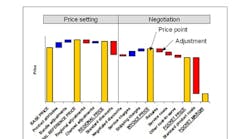Global manufacturers today face a host of challenges to remain competitive and agile in the volatile market. Effectively pricing products and services can be a tremendous competitive weapon if done well, or a liability if poorly executed. Consider the current dynamics for today's global manufacturers: rapidly-fluctuating prices, tougher negotiations with customers, high levels of outsourcing and increased complexity in the channel. These forces combined make strategic pricing a business imperative. When you consider the potential to quickly capture significant ROI, it's no wonder more companies are focusing on pricing now.
As a point of reference, pricing opportunities for a typical organization range from roughly 1% to 3% of sales -- it amounts to $10-$30 million in profits for every $1.0 billion in sales.
Pricing locally and harmonizing globally is about striking the right balance, but what is the best balance between local and global pricing? Pricing locally can negatively impact neighboring markets, while a one-size-fits-all approach to global pricing can leave local opportunities on the table. To use pricing as a competitive advantage, especially during uncertain economic times, manufacturing companies need to focus on pricing strategies. Most importantly, organizations must consider how global prices affect specific local markets and vice versa.
The following best practices will help you "think globally, price locally" to avoid leaving money on the table.
1. Build Consensus on the Need for Change
The most compelling drivers of change for business leaders are size of opportunity for pricing and short time to value, and success stories help bring more stakeholders and company leaders on board. For example, one leading manufacturing assigned strategic pricing management responsibilities to a senior executive who sits on the company's board of directors. Through executive ownership, this manufacturer successfully drove fundamental change in pricing strategies and practices across its global divisions to improve margins.
Beyond executive ownership and before changes are introduced, specific benefits for each pricing-related role within the organization must be identified. Role-based benefits include:
- Sales: Increased commissions using better tools and price guidance
- Product Management: Easier and faster process for setting more consistent, logical prices
- Price Management: Greater consistency and control over the pricing process; improved visibility; less data gathering and more analysis.
With a clearly-articulated opportunity, executives can develop policies and a communication plan to drive pricing best practices into the business. They should also develop a network of pricing professionals within the company to reinforce changes. To ensure success, pilot changes in important but manageable business units, then roll out proven best practices globally.
2. Identify Specific Pricing Opportunities
To identify the highest-impact pricing opportunities, known as Strategic Pricing Opportunities (SPOs), manufacturers should develop a shortlist of key pricing objectives. For example, one company may need to "determine the best price for a given opportunity to maximize capture of that price in the negotiation process." For a different company, "quickly and consistently responding to customer requests with prices based on the specific value delivered to the customer" may be more important. With overall priorities in place, specific global and local improvement opportunities become much easier to coordinate.
A word of caution: Opportunities can be one of two types: price efficiency (manual, error prone, time consuming, inefficient) or price effectiveness (leaving money on the table due to zero or inadequate value-based segmentation, giving away services). The biggest opportunities -- often 60% to 80% of the total -- come from improving price effectiveness, which are generally less apparent to an organization.
3. Improve Pricing Transparency Globally
Global pricing requires a common set of metrics and visibility across local operating companies. A harmonized price waterfall is an invaluable tool in this regard because it graphically shows the sources of profit leakage in a consistent way, from list or reference price down to the pocket margin.
These steps outline how to develop a harmonized price waterfall:
- Define key price points with common definitions globally (e.g. list price, invoice price, net price).
- Brainstorm a list of all possible, controllable adjustments that affect profitability (e.g. charges, rebates, cost-to-serve elements).
- Group and rationalize (harmonize) the list of price points and adjustments according to potential to increase profits. The defined set of waterfall elements should still allow local flexibility within defined boundaries.
4. Harmonize Pricing Practices
Harmonizing pricing processes across an organization means establishing a standard process while allowing a managed degree of variation from the standard. This practice ensures greater visibility, commonality of metrics and lower operating costs. However, it also requires diligent focus because too much harmonization reduces flexibility to support local market conditions, and can be both expensive and time consuming to deploy.
The right level of harmonization will depend on the individual business. For example, a manufacturing company that sells primarily to customers that source globally (e.g. semiconductor manufacturers) needs a high degree of pricing consistency globally, and should therefore be highly centralized with limited local variability. A more regionally-oriented customer base is best served with a less centralized approach, where global processes and tools are harmonized in one model, but also allow local variations.
It's common for local operating units to work within a (pocket) price corridor -- the allowable range of prices between a floor and ceiling, with exceptions requiring corporate approval. These organizations have consistent approaches for monitoring cost-to-serve elements and the ability to choose from a menu of discount and rebates. For one customer, the pocket price corridor reduced cross-border 'grey market' sales (undesirable cross-market sales, typically by distributors) from a significant profit drain to a minor inconvenience.
5. Use Best Practices and Technology to Ensure Sustainable Benefits
Sustaining effective and efficient price and margin management practices requires well-designed pricing processes supported by an enterprise-class pricing solution. Best practices will vary by industry, market and company-specific opportunities. Yet in almost all cases, the price waterfall will aid decision making and the adoption of target prices, encouraging negotiators to set the most appropriate price and ultimately improve margins.
Pricing technology solutions help enforce best practices because they automate the process of setting price targets and price floors, limit price erosion by enforcing price corridors and collect valuable win/loss data for analysis. These tools drive a more consistent and efficient pricing process. One of our customers, for example, uses technology to tie together 30 disparate systems, for the first time providing a coherent view and management structure for global pricing.
Final Thoughts
In today's business environment, global organizations simply can't afford to operate without a strategic approach to global pricing, and global pricing strategies must harmonize with local markets. Market leaders develop global pricing strategies and processes that permeate the entire organization. It all starts with the fundamentals: articulate the opportunity, create and share pricing best practices throughout the organization, improve pricing visibility, and pilot new processes and tools that help you leapfrog ahead. Quick wins can even help build momentum and fund the entire pricing initiative.
Market conditions, customer demands, and competitive pressures mandate a strategic, harmonized approach, and manufacturing companies that price locally and harmonize globally now will weather the economic storm and ensure a competitive advantage as the economy recovers.
The proof is in the results. As one manufacturer attests, "Our pricing project has been one of the most successful profit initiatives we have done in many years." Bottom line: pricing is so valuable that it must be a core focus for your business.
Dr. Ian Tidswell is the head of Vendavo's Business Consulting Team in Europe. Vendavo is a provider of price management and optimization software for business-to-business companies worldwide www.vendavo.com.




